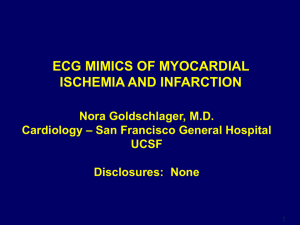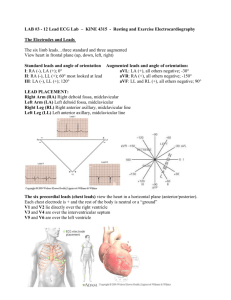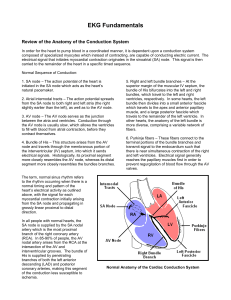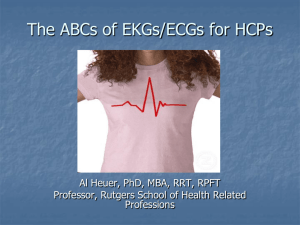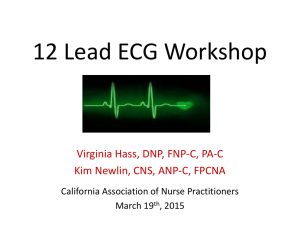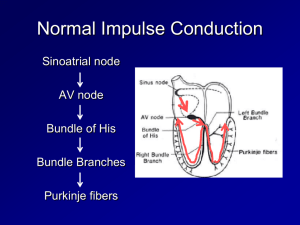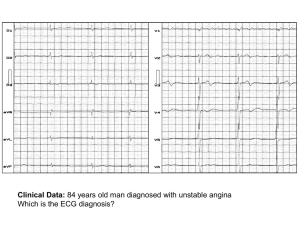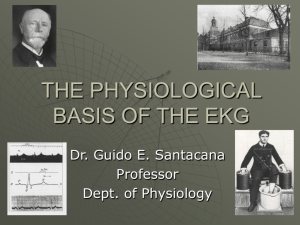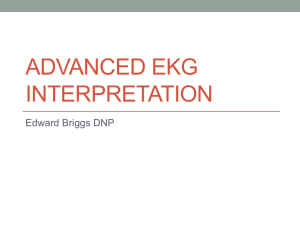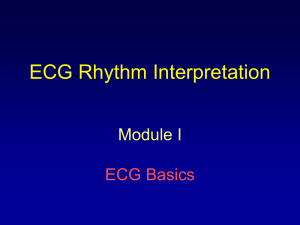ECG BASICS
advertisement
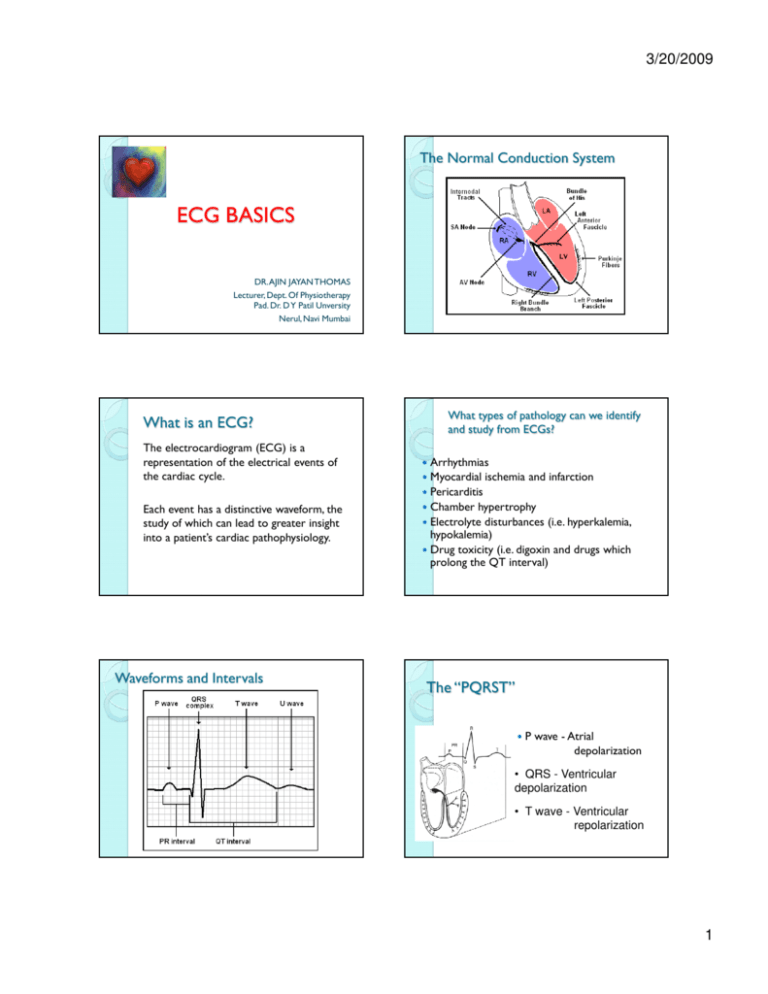
3/20/2009 The Normal Conduction System ECG BASICS DR. AJIN JAYAN THOMAS Lecturer, Dept. Of Physiotherapy Pad. Dr. D Y Patil Unversity Nerul, Navi Mumbai What types of pathology can we identify and study from ECGs? What is an ECG? The electrocardiogram (ECG) is a representation of the electrical events of the cardiac cycle. Each event has a distinctive waveform, the study of which can lead to greater insight into a patient’s cardiac pathophysiology. Waveforms and Intervals Arrhythmias Myocardial ischemia and infarction Pericarditis Chamber hypertrophy Electrolyte disturbances (i.e. hyperkalemia, hypokalemia) Drug toxicity (i.e. digoxin and drugs which prolong the QT interval) The “PQRST” P wave - Atrial depolarization • QRS - Ventricular depolarization • T wave - Ventricular repolarization 1 3/20/2009 ECG Leads Leads are electrodes which measure the difference in electrical potential between either: ECG Leads The standard ECG has 12 leads: 3 Standard Limb Leads 3 Augmented Limb Leads 6 Precordial Leads 1. Two different points on the body (bipolar leads) 2. One point on the body and a virtual reference point with zero electrical potential, located in the center of the heart (unipolar leads) The axis of a particular lead represents the viewpoint from which it looks at the heart. Standard Limb Leads Standard Limb Leads Augmented Limb Leads All Limb Leads 2 3/20/2009 Precordial Leads Precordial Leads Adapted from: www.numed.co.uk/electrodepl.html Summary of Leads Bipolar Arrangement of Leads on the EKG Limb Leads Precordial Leads I, II, III - (standard limb leads) Unipolar aVR, aVL, aVF V1-V6 (augmented limb leads) Anatomic Groups Anatomic Groups (Septum) (Anterior Wall) 3 3/20/2009 Anatomic Groups Anatomic Groups (Lateral Wall) (Inferior Wall) Anatomic Groups Determining the Heart Rate (Summary) Rule of 300 Rule of 300 10 Second Rule What is the heart rate? Take the number of “big boxes” between neighboring QRS complexes, and divide this into 300. The result will be approximately equal to the rate Although fast, this method only works for regular rhythms. 4 3/20/2009 What is the heart rate? What is the heart rate? HEART RATE? The Rule of 300 It may be easiest to memorize the following table: 10 Second Rule # of big boxes Rate 1 300 2 150 3 100 4 75 5 60 6 50 What is the heart rate? As most ECGs record 10 seconds of rhythm per page, one can simply count the number of beats present on the EKG and multiply by 6 to get the number of beats per 60 seconds. This method works well for irregular rhythms. 5 3/20/2009 The QRS Axis The QRS axis represents the net overall direction of the heart’s electrical activity. Abnormalities of axis can hint at: Ventricular enlargement Conduction blocks (i.e. hemiblocks) Determining the Axis The Quadrant Approach The Equiphasic Approach The QRS Axis By near-consensus, the normal QRS axis is defined as ranging from -30 to +90 . -30 to -90 is referred to as a left axis deviation (LAD) +90 to +180 is referred to as a right axis deviation (RAD) Determining the Axis Predominantly Positive The Quadrant Approach 1. Examine the QRS complex in leads I and aVF to determine if they are predominantly positive or predominantly negative. The combination should place the axis into one of the 4 quadrants below. Predominantly Negative Equiphasic The Quadrant Approach 2. In the event that LAD is present, examine lead II to determine if this deviation is pathologic. If the QRS in II is predominantly positive, the LAD is non-pathologic (in other words, the axis is normal). If it is predominantly negative, it is pathologic. 6 3/20/2009 Quadrant Approach: Example 1 Quadrant Approach: Example 2 MYOCARDIAL INFARCTION HEART BLOCK Normal ECG ST Segment Elevation Development of Q waves ST segment returns to baseline T waves become inverted MYOCARDIAL ISCHEMIA ◦ ST Segment depression RBBB: RSR1 Pattern in V1 LBBB: Notched R wave in V6 FIRST DEGREE HEART BLOCK- PR MORE THAN 200ms SECOND DEGREE HEART BLOCK MOBITZ TYPE 1: Constant PP interval, progressive PR, followed by dropped beat- WENCKEBACH PHENOMENA MOBITZ TYPE 2- P wave not followed by a QRS complex / constant PR / slightlty wide QRS complexes – likely to progress to third degree THIRD DEGREE HEART BLOCK- When p waves are not followed by QRS for several beats (3:1 /4:1)/ ventricular rate usually 30-40 bpm SUSTAINED VENTRICULAR TACHYCARDIA VENTRICULAR PREMATURE COMPLEXES 7 3/20/2009 THANK YOU ajinjt_physio@yahoo.com 8





